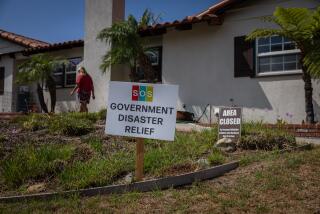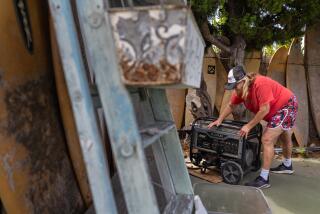Laguna Residents Warned of Instability After Slides
LAGUNA BEACH — Four days after mudslides buried homes and killed two people, city officials alerted the residents of 25 canyon homes Friday that their properties might be unstable and suggested they hire engineers to determine the safety of the ground.
The warning letters come as weary residents ponder whether to continue living in a community beset by natural disasters.
While many mudslide victims have vowed to remain in the canyon, some people are questioning the wisdom of rebuilding in areas that seem perpetually in Mother Nature’s path.
“We need to ask whether these areas were intended to have this population density,” Laguna Beach Councilman Wayne J. Baglin said. “These are dramatically beautiful areas, but they are prone to failure. I think some people are getting uneasy about the idea of digging out and building again.”
Baglin’s view was echoed by some mudslide victims as well as government officials and urban planners, who noted that much of the emergency response to this winter’s El Nino-powered storms has been to a handful of high-risk areas such as Laguna Canyon and wave-battered Seal Beach.
In an example of the fire-landslide cycle that afflicts many local canyons, the same hillside homes inundated with mud this week were threatened by the 1993 Laguna fire that damaged or destroyed more than 400 houses.
A similar debate is occurring in other disaster-prone areas, such as Malibu and the small towns in Central California’s vast flood plain. Meanwhile, the Federal Emergency Management Agency is beginning to encourage some disaster victims to relocate rather than rebuild in areas with a history of problems.
“What society is doing in a sense is subsidizing development in dangerous areas,” said Scott Bollens, an associate professor of urban planning at UC Irvine. “You have a fire or a mudslide, and the government comes in to help control the problems and rebuild. There’s nothing more honorable than helping people after a disaster. But it’s a circle.”
The warning letters were sent after a city-hired geologist examined dozens of properties in and around the muddy canyon.
The city also “strongly recommends” that the residents of the 25 properties evacuate to more secure ground during periods of “moderate or severe rainstorms,” according to the letter.
Despite this week’s damage, some canyon residents expressed little interest in moving.
“I still love this place. It’s beautiful,” said Gary Lemonoff, a 10-year canyon dweller whose trailer was pushed several feet by the torrent of mud. “The nature here is wonderful--even when it rains.”
But Debbie Ripley, who moved into the canyon two weeks before the 1993 fire, said Monday’s mudslides have given her pause.
“There’s too much damage to deal with it,” said Ripley, who had to climb onto the roof of her home to avoid being swept up in a river of mud. “I think we’ll move.”
The string of recent calamities has city officials reexamining their rebuilding policies and looking for ways to make their community less susceptible to repeated damage.
Baglin and a few others also have raised the controversial subject of buying out homeowners who live in the highest-risk areas.
The city’s Laguna Canyon Road Oversight Committee is scheduled at its next meeting to discuss a 30-year-old U.S. Army Corps of Engineers report that looked at the costs of buying some homes in severe landslide zones and preserving the area as open space.
“I don’t think homeowners at first blush would be enthusiastic . . . about selling out,” he said. “But I think there is agreement that something must be done.”
President Clinton on Thursday declared Orange County eligible for federal disaster assistance, and FEMA Director James Lee Witt toured the mudslide area. But it remains unknown whether victims would qualify for FEMA’s relocation program. Most of the agency’s relocations have occurred in communities along the Mississippi River that were devastated by the 1993 flood.
Before then, FEMA focused primarily on helping disaster victims get the money to rebuild their damaged properties. But the seriousness of the 1993 flood prompted the agency to buy more than 10,000 pieces of property in the danger zones.
The best known example of relocation occurred in the small town of Valmeyer, Ill., where 600 residents moved to a bluff overlooking the city.
“FEMA is increasingly looking at ways of discouraging from building in high-risk areas,” said agency spokeswoman Val Bunting. “We are attempting to take people who are hit time and time again and moving them to areas that don’t have that cycle of nature.”
So far, no FEMA resettlements have occurred in California. And some urban planners doubt it could be successful.
“In California, there is an ingrained sense that it’s your property, and you can do whatever you want with it,” said Sandra Sutphen, a disaster preparedness expert and political science professor at Cal State Fullerton. “The property is too expensive, and people don’t want to give up their beach and hillside properties.”
Many of the homes in Laguna Canyon’s danger zones were erected before strict building safety regulations were enacted. Some would probably be prohibited under current law.
In the wake of the 1993 fire, the city toughened its codes to require more extensive geological studies of building sites in the hills. But the City Council rejected other proposals aimed at better protecting new homes against fires, such as the use of noncombustible siding.
While the city hasn’t bought out any homeowners, it and other government agencies have slowly purchased hundreds of acres of land around Laguna Canyon for open space and to prevent hillside development.
The city also could consider stabilizing weak hillsides. But officials said such an undertaking would be prohibitively expensive.
Even before this week’s mudslide, weather-related damage to property in Laguna Beach had topped $2 million since December. The city is heavily reliant on FEMA to help pay for repairs.
“Without the emergency aid, a small community like ours would be devastated,” City Manager Kenneth C. Frank said.
But officials have expressed concern about FEMA rules that require that damaged property be restored to its original condition--even if that condition makes it vulnerable to future natural calamities.
The major storm in December, for example, battered the city’s boardwalk at Main Beach, but FEMA would cover only basic restoration costs. So the city is using its own money to add several pilings to secure the boardwalk.
“We want to get to a point when we are not repeat problems time and time again,” Baglin said. “We find ourselves on the news a lot when it comes to these disasters. We don’t think that’s a good thing.”
Times staff writer David Reyes contributed to this report. Shelby Grad can be reached at (714) 564-1051 or by e-mail at shelby.grad@latimes.com
More to Read
Sign up for Essential California
The most important California stories and recommendations in your inbox every morning.
You may occasionally receive promotional content from the Los Angeles Times.











